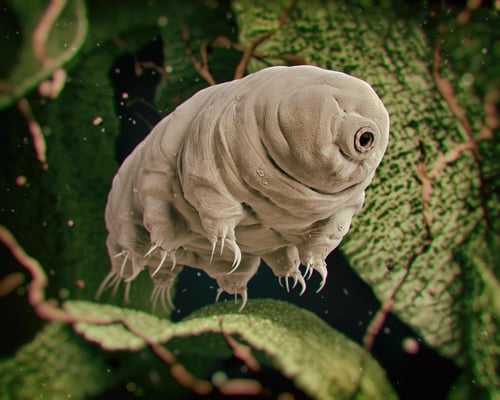Have you ever heard of an animal that can survive in boiling water, in below freezing temperatures and even in the depths of space? Well if not, then you should probably learn about the microscopic organisms called Tardigrades. They are commonly referred to as “water bears” or “moss piglets” because of their shape and preference for living in damp conditions like moss or lichens. You may have even seen them in the popular Marvel movie “Ant-Man”.

What the tardigrade looks like close-up.
Tardigrades are not really that similar to bears, contrary to what their name may imply. They are invertebrates that are most closely related to arthropods such as insects or crustaceans and are found in many environments from oceans to even mountaintops. Tardigrades are about 0.5mm in length, so in the right conditions you might be able to see them with the naked eye, but in general they need a microscope in order to be seen.
They have a peculiar body shape with four body segments with a pair of short legs and claws on each. But despite having so many legs, they do not walk or move very quickly. They prefer to slide along with the flow of water or wind and use their legs for grasping and to propel themselves forward. Their penchant for slowness is actually the origin of their name because tardigrada in Latin means “slow walker.”
The phylum of tardigrade encompasses a wide range of species with over 900 named. All Tardigrades are considered aquatic because they need water around their bodies but they have been found in freshwater, marine and semiaquatic terrestrial environments. Some of them are herbivores and can suck fluids from plant cells, while others can be only carnivorous and eat organisms like nematodes and even other tardigrades!
But among the most remarkable features of the tardigrades is their incredible resilience to surrounding environments. Tardigrades have been subjected to a litany of different conditions to test their ability to survive in extreme scenarios. They have been exposed to below -200° C temperatures for 20 months and were able to be warmed back to life, and also been exposed to over 150° C and survived that as well. They have even been released to the vacuum and harsh radiation of space for over 10 days and have been able to revive.
So how do the tardigrades do it? Well they are able to enter a “tun state” under extreme conditions, which is a state of suspended animation where the body is able to dry out and pause physiological processes like metabolism. During this state they appear as a lifeless ball about one-third its typical size. In this state they can lose up to 97% of their body moisture and their metabolism can decline to as little as 0.01% of its normal rate.
Because of the tardigrades incredible resilience, they have been the subject of research for potential applications for humans. One interesting application was a recent study from the University of Wyoming which shows how tardigrade proteins could potentially be used “to treat people with hemophilia and other conditions without the need for refrigeration -- even amid high temperatures and other difficult conditions”. There has also been research on the tardigrades’ ability to withstand radiation and how tardigrade protein can be used to increase human cell’s radiation resilience.
So the next time you think about the incredible resilience of the animal kingdom, you don’t have to think very big because water bears, one of the most resilient animals on Earth, might be right under your nose if you look under the right microscope.
Reese Farrow is the Lead Naturalist at Walking Mountains Science Center and he wishes that he could enter a “tun state” sometimes.







